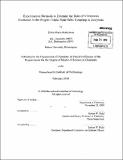| dc.contributor.advisor | Robert W. Field. | en_US |
| dc.contributor.author | Robertson, Erika Marie | en_US |
| dc.contributor.other | Massachusetts Institute of Technology. Dept. of Chemistry. | en_US |
| dc.date.accessioned | 2010-08-31T14:33:08Z | |
| dc.date.available | 2010-08-31T14:33:08Z | |
| dc.date.copyright | 2010 | en_US |
| dc.date.issued | 2010 | en_US |
| dc.identifier.uri | http://hdl.handle.net/1721.1/57774 | |
| dc.description | Thesis (S.M.)--Massachusetts Institute of Technology, Dept. of Chemistry, 2010. | en_US |
| dc.description | Cataloged from PDF version of thesis. | en_US |
| dc.description | Includes bibliographical references (p. 46-49). | en_US |
| dc.description.abstract | Despite being a seemingly simple molecule, acetylene has a complicated electronic structure that has been studied extensively both experimentally and theoretically. Acetylene has been observed to have a complex spin-orbit coupling mechanism where the first excited singlet state S couples to the triplet state T3 which is then coupled to the dense manifold of vibrational states in the T, 2 electronic states. A description of theories imperative to this study is provided and each is related to its application in experiment. A description of how to obtain important parameters in the coupling, such as the coupling strength, the singlet-triplet mixing fraction, the radiative lifetime, and the relative energy ordering and separation between the singlet and coupled triplet, is given. Finally, key vibrational levels of interest that should be investigated are described. | en_US |
| dc.description.statementofresponsibility | by Erika Marie Robertson. | en_US |
| dc.format.extent | 49 p. | en_US |
| dc.language.iso | eng | en_US |
| dc.publisher | Massachusetts Institute of Technology | en_US |
| dc.rights | M.I.T. theses are protected by
copyright. They may be viewed from this source for any purpose, but
reproduction or distribution in any format is prohibited without written
permission. See provided URL for inquiries about permission. | en_US |
| dc.rights.uri | http://dspace.mit.edu/handle/1721.1/7582 | en_US |
| dc.subject | Chemistry. | en_US |
| dc.title | Experimental methods to examine the role of vibrational excitation in the singlet-triplet spin-orbit coupling in acetylene | en_US |
| dc.type | Thesis | en_US |
| dc.description.degree | S.M. | en_US |
| dc.contributor.department | Massachusetts Institute of Technology. Department of Chemistry | |
| dc.identifier.oclc | 630715019 | en_US |
